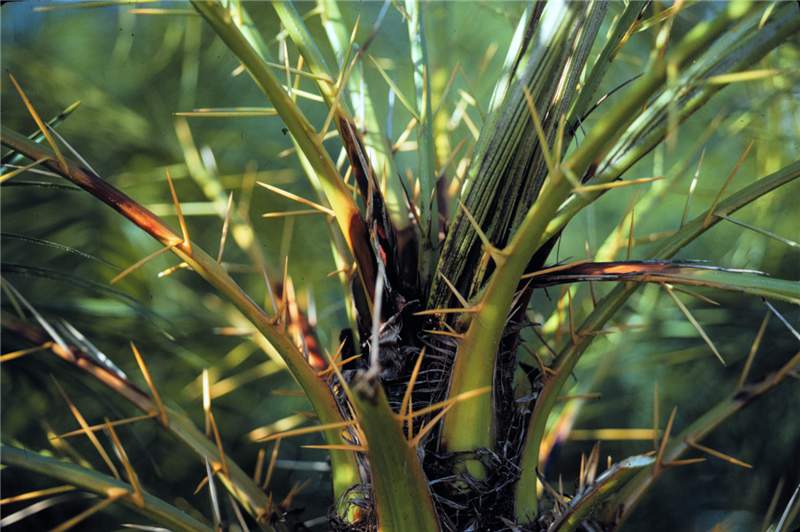Pestalotiopsis Rachis Blight and Crown Rot
|
Figure 1. The rachis blight lesions appear black and sunken on this palm rachis. As the lesions expand together, larger areas of blighted rachis tissue develop. Photo by M. L. Elliott.
|
|
Figure 2. Large, dark lesions have formed near or on the leaf base of all the rachides of this Phoenix roebelenii canopy. These lesions often continue to expand, and the fungus will infect the spear leaf and the apical meristem causing a bud and crown rot. Photo by T. K. Broschat. |
Scientific name of pathogen
Pestalotiopsis sp., probably Pestalotiopsis palmarum: Kingdom Fungi, Imperfect Fungi (no known sexual state)
Hosts
A large number of palms are listed as hosts for Pestalotiopsis palmarum, but these are in association with leaf spot diseases. Pestalotiopsis rachisrachis:
the axis of a leaf beyond the petiole or an extension of the petiole into the leaf blade
blight and crowncrown:
see canopy
rot is primarily associated with Phoenix roebelenii.
Distribution
Pestalotiopsis spp. have a world wide distribution.
Symptoms/signs
Pestalotiopsis sp. can cause a typical leaf spot of numerous palm species, but on Phoenix roebelenii, it causes a serious rachisrachis:
the axis of a leaf beyond the petiole or an extension of the petiole into the leaf blade
blight that often leads to a crowncrown:
see canopy
rot. It is reported to cause a general decline of Butia capitata and act as an opportunistic pathogen of insect-wounded Areca catechu trunks and leaf bases.
On Phoenix roebelenii, relatively large (1 inch or more) lesions develop on the rachides. These lesions may coalesce to form large areas of blighted rachisrachis:
the axis of a leaf beyond the petiole or an extension of the petiole into the leaf blade
tissue (Fig. 1). Lesions may develop at the same time on the spines and even on the leaves. Of concern, however, are the lesions that develop on young leaves in the canopycanopy:
the cluster of leaves borne at the tip of the stem
on the portion of the rachides closest to the apical meristemmeristem:
the growing region of a plant, a special area of undifferentiated cells wherein new cells and organs are developed
(Fig. 3). Lesions can coalesce and expand along the rachides towards the apical meristemmeristem:
the growing region of a plant, a special area of undifferentiated cells wherein new cells and organs are developed
, eventually infecting and killing the apical meristemmeristem:
the growing region of a plant, a special area of undifferentiated cells wherein new cells and organs are developed
.



